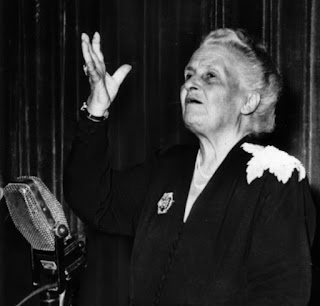My strength is taking knowledge about body work and birth anatomy and turning it into simple and practice methods to help babies start and fulfill birth with the physical power of themselves and their mothers. In other words, I help parents and providers know what to do when to return labor to a normal progression.
I admire people like Marsden Wagner, Rebecca Dekker, Henci Goer and Penny Simkin who take current literature and relate it to current practice.
My talent is more humble, less institutionally trained, and has more to do with visuals. I take what we know on paper and help midwives know it in their hands. The things “we know” are not always common knowledge, sometimes I learned them at a birth and then found them in the literature often ignored because no one realized the importance of taking subtle concepts and illustrating them so that others could understand it. How do I do this? It began with my first teacher.
 |
| Maria Montessori 1933 |
Maria Montessori was a graduated medical doctor – the first modern Female Doctor in Italy. She overcame great obstacles, like having to dissect cadavers alone after dark with only a candle to light her explorations of the human form. She was not allowed to practice with the boy’s club.
A crisis in the municipal housing projects brought her to early childhood education where she inspired the likes of Piaget, whom she turned down to work with her because he was too proud to sit on the floor with children. Instead she choose the janitor’s daughter because she came with no miseducated ideas about how children learn.
 |
| The Great Educator 1949 |
Maria Montessori said, “through the hand into the mind.” She taught kinesthetically and systematically. She knew more about children because, as she said, The child is the teacher, and she was an excellent, observant student. She noticed how stimulating the world was to the child, many details flooded the child’s attention. She simplified each detail into a “lesson” and then let a series of subsequent lessons lead the child spontaneously back to the conclusion of the whole. In her first year with the preschool children, the group of them began to spontaneously read and write because each of the separate details of how to hold a small object, how to sound the letters, to trace a letter, to hold a pen, all cumulated into the whole of writing. The children learned with several steps of success because they didn’t have to sit down and learn the entirety in a week or a month.
One way Maria Montessori learned to show child a complex concept was to begin with the the 3-dimensional objects representing the concept. For instance, I’ll use the same example I used in making my teaching manual during Montessori training in 1981.
The small child approaches Advent. They have the figurines of a Nativity Scene/ Later they hold a flat object, like a puzzle, of the same scene. Finally, an abstract such as a painting.
This process is a formal version of a more simple and rapid approach in which I show anatomy and concepts for the Spinning Babies premise to experienced birth workers. In this way we can show the reality of gentleness in preparing for and in assisting the natural progression of labor.
Here is a picture of me with Madame Elizabeth Caspari, Maria Montessori’s friend and personal secretary. Together they met in India just as WWII broke out. They spent the next four years in a locked containment camp called a “hill station.” Using their time constructively there, they began to develop Montessori in botany, music, math and English language. These are the gifts Madame Caspari brought. She had been a famous children’s music teacher in Paris, though she herself was Italian like Madame Montessori. In 1946, Elizabeth Caspari introduced Montessori to America in St. Louis at her first Children’s House.
 |
| Madame Elizabeth Caspari, 88, with Gail Tully, 20, in 1980 |
I spent 9 months near her, including the first cycle of Montessori training after which I left for University and plans to become a midwife. I later decided to become a CPM through practical learning and not institutionalized education, though I did get a BS in Family Dynamics. Because I followed Madame Caspari around, often sitting by her feet on the floor, she called me her “little chick.”
I can only thank these women and my family tree of teachers, plus an older brother who loved to teach me by Socratic method as to why my workshops win frequent praise and being the best education that many midwives have experienced. Are you a kinesthetic learner? You may like the workshop. Are you an experienced midwife? What you know that is not in the books will be validated and you will feel enthused. That is simply the nature of finding your own.
